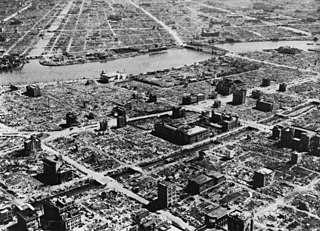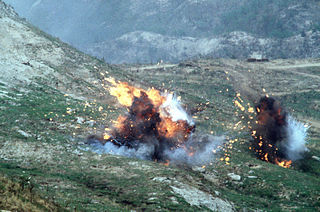
Warden's Five Rings represent a theory of military strategic attack, based on five levels of system attributes. They are named in honor of Col. John A. Warden III, a former United States Air Force officer and theorist of air power.
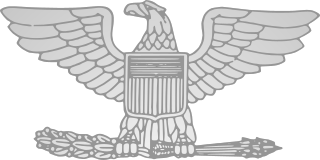
In the United States Army, Marine Corps, and Air Force, colonel is the most senior field grade military officer rank, immediately above the rank of lieutenant colonel and immediately below the rank of brigadier general. It is equivalent to the naval rank of captain in the other uniformed services. The pay grade for colonel is O-6.
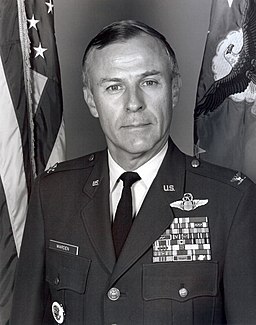
John Ashley Warden III is a retired colonel in the United States Air Force. Warden is a graduate of the United States Air Force Academy. His Air Force career spanned 30 years, from 1965 to 1995, and included tours in Vietnam, Germany, Spain, Italy, and Korea, as well as many assignments within the continental United States. Warden completed a number of assignments in the Pentagon, was a Special Assistant for Policy Studies and National Security Affairs to the Vice President of the United States, and was Commandant of the Air Command and Staff College.

The United States Air Force (USAF) is the aerial and space warfare service branch of the United States Armed Forces. It is one of the five branches of the United States Armed Forces, and one of the seven American uniformed services. Initially formed as a part of the United States Army on 1 August 1907, the USAF was established as a separate branch of the U.S. Armed Forces on 18 September 1947 with the passing of the National Security Act of 1947. It is the youngest branch of the U.S. Armed Forces, and the fourth in order of precedence. The USAF is the largest and most technologically advanced air force in the world. The Air Force articulates its core missions as air and space superiority, global integrated intelligence, surveillance, and reconnaissance, rapid global mobility, global strike, and command and control.
Contents
The Five Rings include:
- Leadership
- Organic/System Essentials/Key Production
- Infrastructure
- Population
- Fielded Military Forces
Leadership is both a research area and a practical skill encompassing the ability of an individual or organization to "lead" or guide other individuals, teams, or entire organizations. Specialist literature debates various viewpoints, contrasting Eastern and Western approaches to leadership, and also United States versus European approaches. U.S. academic environments define leadership as "a process of social influence in which a person can enlist the aid and support of others in the accomplishment of a common task".

Infrastructure is the fundamental facilities and systems serving a country, city, or other area, including the services and facilities necessary for its economy to function. Infrastructure is composed of public and private physical improvements such as roads, bridges, tunnels, water supply, sewers, electrical grids, and telecommunications. In general, it has also been defined as "the physical components of interrelated systems providing commodities and services essential to enable, sustain, or enhance societal living conditions".

In biology, a population is all the organisms of the same group or species, which live in a particular geographical area, and have the capability of interbreeding. The area of a sexual population is the area where inter-breeding is potentially possible between any pair within the area, and where the probability of interbreeding is greater than the probability of cross-breeding with individuals from other areas.
Each level of system or "ring" was considered one of the enemy's centers of gravity. The idea behind Warden's five rings was to attack each of the rings to paralyze their forces, an objective also known as physical paralysis. To optimize a strike attack the attacker would engage as many rings as possible with special emphasis on taking out the center ring, which is the enemy's leadership. This would result in total physical paralysis.
Paralysis is a loss of muscle function for one or more muscles. Paralysis can be accompanied by a loss of feeling in the affected area if there is sensory damage as well as motor. In the United States, roughly 1 in 50 people have been diagnosed with some form of permanent or transient paralysis. The word comes from the Greek παράλυσις, "disabling of the nerves", itself from παρά (para), "beside, by" and λύσις (lysis), "making loose". A paralysis accompanied by involuntary tremors is usually called "palsy".
Warden's theories on the application of air power in modern war have been criticized as little more than a reiteration of earlier strategic bombing concepts discredited by historical analysis of the Second World War and the Vietnam War, similar to the effect on the writings of Giulio Douhet. Warden differs from Douhet in assigning leadership the highest priority, where Douhet espoused attacking the morale of populations. This made Warden's theory more applicable for attacking developing and weaker regimes, while Douhet's theories were based on stronger nations engaged in large conventional wars as was the concern in interwar Europe. Dismissal of the theories has led some to mistakenly conclude that the theories have no application, thereby missing the application of air power as a modern means of accomplishing the Strategic Indirect of Sir B. H. Liddell Hart.

The Vietnam War, also known as the Second Indochina War, and in Vietnam as the Resistance War Against America or simply the American War, was an undeclared war in Vietnam, Laos, and Cambodia from 1 November 1955 to the fall of Saigon on 30 April 1975. It was the second of the Indochina Wars and was officially fought between North Vietnam and South Vietnam. North Vietnam was supported by the Soviet Union, China, and other communist allies; South Vietnam was supported by the United States, South Korea, the Philippines, Australia, Thailand and other anti-communist allies. The war is considered a Cold War-era proxy war from some US perspectives. It lasted some 19 years with direct U.S. involvement ending in 1973 following the Paris Peace Accords, and included the Laotian Civil War and the Cambodian Civil War, resulting in all three countries becoming communist states in 1975.
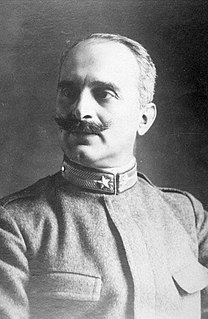
General Giulio Douhet was an Italian general and air power theorist. He was a key proponent of strategic bombing in aerial warfare. He was a contemporary of the 1920s air warfare advocates Walther Wever, Billy Mitchell and Hugh Trenchard.
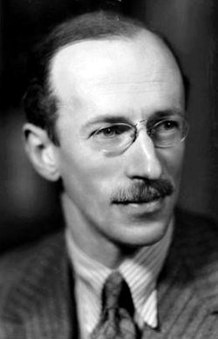
Sir Basil Henry Liddell Hart, commonly known throughout most of his career as Captain B. H. Liddell Hart, was a British soldier, military historian and military theorist. In the 1920s and later he wrote a series of military histories that proved influential among strategists. He argued that frontal assault was a strategy that was bound to fail at great cost in lives, as happened in 1914-1918. He instead recommended the "indirect approach" and reliance on fast-moving armoured formations.
